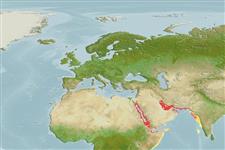Environment: milieu / climate zone / depth range / distribution range
Écologie
marin récifal; profondeur 3 - 50 m (Ref. 9710). Tropical
Western Indian Ocean: Red Sea and the Gulf of Aden.
Taille / Poids / Âge
Maturity: Lm ? range ? - ? cm
Max length : 18.0 cm TL mâle / non sexé; (Ref. 9710)
Found on coral slopes (Ref. 9710) Juveniles in large groups at base of reef, sometimes with H. diphreutes; adults usually solitary or paired, occasionally in groups (Ref. 9710). Feed on zooplankton and benthic invertebrates (Ref. 9710). Oviparous (Ref. 205), monogamous (Ref. 52884). Form pairs during breeding (Ref. 205).
Life cycle and mating behavior
Maturities | Reproduction | Spawnings | Egg(s) | Fecundities | Larves
Distinct pairing (Ref. 205). Monogamous mating is observed as both obligate and social (Ref. 52884).
Robins, C.R., R.M. Bailey, C.E. Bond, J.R. Brooker, E.A. Lachner, R.N. Lea and W.B. Scott, 1991. World fishes important to North Americans. Exclusive of species from the continental waters of the United States and Canada. Am. Fish. Soc. Spec. Publ. (21):243 p. (Ref. 4537)
Statut dans la liste rouge de l'IUCN (Ref. 130435)
Menace pour l'homme
Harmless
Utilisations par l'homme
Pêcheries: commercial; Aquarium: Commercial
Outils
Articles particuliers
Télécharger en XML
Sources Internet
Estimates based on models
Preferred temperature (Ref.
123201): 24.7 - 29.4, mean 27 °C (based on 130 cells).
Phylogenetic diversity index (Ref.
82804): PD
50 = 0.5039 [Uniqueness, from 0.5 = low to 2.0 = high].
Bayesian length-weight: a=0.02239 (0.01117 - 0.04486), b=3.02 (2.85 - 3.19), in cm total length, based on LWR estimates for this (Sub)family-body shape (Ref.
93245).
Niveau trophique (Ref.
69278): 3.5 ±0.41 se; based on food items.
Résilience (Ref.
120179): Haut, temps minimum de doublement de population inférieur à 15 mois (Preliminary K or Fecundity.).
Fishing Vulnerability (Ref.
59153): Low vulnerability (10 of 100).
Nutrients (Ref.
124155): Calcium = 92.2 [47.9, 143.6] mg/100g; Iron = 0.784 [0.462, 1.285] mg/100g; Protein = 18.7 [17.6, 19.8] %; Omega3 = 0.126 [0.077, 0.200] g/100g; Selenium = 34.4 [19.3, 64.5] μg/100g; VitaminA = 51.1 [15.1, 167.6] μg/100g; Zinc = 1.3 [0.9, 1.9] mg/100g (wet weight);
